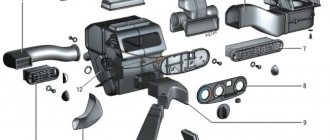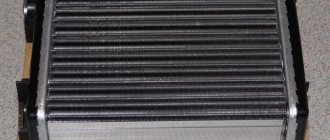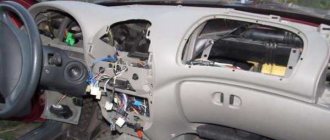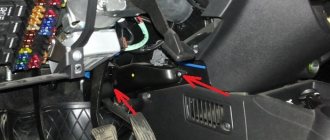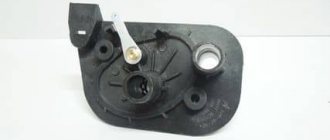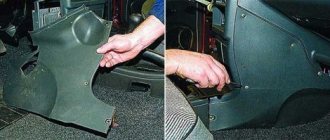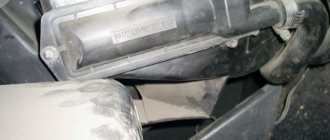The “weak point” in the interior heating system of the VAZ Kalina is the heater radiator. The heat exchanger on this car is made of aluminum (tubes and honeycombs) and plastic (tanks), so the service life of this part is not that long. Over time, the radiator loses its seal and begins to leak, which can lead to serious problems. The designers placed the engine ECU under the heater housing. If the radiator leaks, the antifreeze flowing from it gets onto the control unit, which causes it to burn out.
There is only one way to solve the issue of a leaking heater radiator on a VAZ Kalina - replace the damaged heat exchanger with a new one, since aluminum heater radiators are not repairable. But here a second problem arises - how best to carry out the replacement. The heater on the VAZ Kalina was not designed well, so replacing the radiator is a complicated procedure.
According to the automaker's recommendation, replacing the heater radiator with a Kalina can only be done by removing the front panel from the car. Removing the panel is a labor-intensive operation due to the large number of fasteners, and at the same time it is necessary to dismantle a number of interior elements - the front seats, steering column, pedal unit. An additional negative factor in replacing the heater radiator on a VAZ Kalina with removing the front panel is the appearance of “crickets” after assembly.
The only advantage of the replacement technology recommended by the automaker is that no alterations or modifications to the heater are required to remove or install the heat exchanger. Car enthusiasts have come up with alternative methods for replacing the heater radiator without removing the front panel, but each option has disadvantages.
Features and nuances of the heater design
Note that problems during replacement are caused not by dismantling, but by installing a new radiator. There are two main nuances that make it difficult to fit the heat exchanger into the heater housing. The first one is the installation side. The radiator is pulled out towards the pedal block, and the pedals themselves prevent the radiator from “coming out”. But this does not cause problems during dismantling, since the leaking heat exchanger can be sawed and removed. But it’s impossible to install a new radiator because of the pedals.
The second nuance is the design of the radiator itself. The heat exchanger fittings for connecting the cooling system pipelines are long and pass through the engine shield. Thanks to this, the connection of the pipes with the radiator is carried out in the engine compartment and if the fastening clamps are loosened, the antifreeze flowing through the leak does not enter the passenger compartment. But due to the long fittings, you can only pull out the heater radiator by moving the heater housing toward the passenger compartment, and this is only possible with the front panel removed.
The replacement methods that car enthusiasts have come up with involve some modifications to the heater elements, allowing the installation of a heater radiator. In the future, these modifications make it possible to replace the heat exchanger without problems and in a short time.
Without removing the windshield
In this case, the windshield protective cover and cabin filter remain in place. Roughly speaking, there are fewer preparatory operations. But the algorithm for the main stage of work is radically different from the traditional one. It looks like this:
- Disconnect the accelerator pedal cable.
- We remove the pedal.
- We are dismantling the sensor for turning on the rear parking lights.
- We disconnect the brake pedal from its drive by disabling the clamp and the metal pin.
- Remove the steering column.
- Remove the trim on the left side of the dashboard.
Location and principle of operation of the stove
With the onset of cold weather, many motorists are faced with the problem of heating their car. This is a very common breakdown in which heat does not flow into the car interior, which makes being in it insufficiently comfortable. Let's first figure out how our stove works. The operating principle of the heater is as follows:
- Through the air filter, air from the street first enters the air intake. Then, using electric fans, it is driven inside the air ducts.
- The intake air is heated using a heater (heater radiator), which is located under the protective panel.
- While the engine is running, heated coolant circulates through the radiator, thereby heating the air flowing through it.
- Adjustment of the air supply speed, as well as temperature adjustment and damper control is carried out using a control unit located in the central part of the dashboard.
The process of replacing the Lada Kalina stove consists of several stages
The location of the stove on Kalina is convenient; it is located in the central part of the torpedo. The control of the switching mechanisms is quite simple, carried out by four regulators. Repair of the Lada Kalina stove can be divided into several stages: diagnostics and troubleshooting, disassembly and assembly of the necessary mechanisms and repair (replacement) of failed parts.
Required tools and accessories
For repair you will need:
- a set of screwdrivers of various lengths;
- socket wrenches;
- set of open-end wrenches;
- container for draining antifreeze from the cooling system;
- sharp knife;
- new radiator.
In the service, the replacement procedure costs a lot of money, and not every master will take on the job. It's not a matter of qualified repairs; anyone who knows how to hold keys in their hands can do it. It’s just that the replacement process is labor-intensive, requires accuracy and patience, and many parts are very inconvenient to dismantle.
You definitely need to put the Kalina in the garage, with the expectation that in the absence of proper qualifications, repairs may take several days. You should take care of lighting and, if possible, basic heating in advance if it is cold outside.
How to choose the right heater radiator
When choosing a suitable radiator from a fairly extensive range, you should remember a few simple rules.
First of all, you need to pay attention to the metal from which the heating system element is made. Cheap options are made of aluminum. If it cracks, the owner has only one choice - throw it away and buy a new one.
Meanwhile, the brass-copper model, although more expensive, can be easily repaired - cracks in it can be easily sealed.
It is also important that the swirlers of the new radiator are made of durable plastic. As practice shows, such models last for many years and rarely become clogged.
Preparatory process with preliminary disassembly
To ensure the ability to carry out repair work to replace the radiator, you will need to acquire the following tools:
- locksmith set, which includes a wide range of standard keys;
- a hacksaw for metal with the ability to extend the blade;
- a container paired with a hose to drain antifreeze;
- silicone sealant or other means for gluing plastic;
- with a rag.
During the procedure for replacing the heater in the LADA Kalina model, we also recommend replacing its power supply and return pipes. On old hoses there is a high probability of cracks appearing, which can manifest themselves unexpectedly and negatively. This approach will eliminate the need to repeat the labor-intensive disassembly procedure in order to replace the pipes
We advise you to pay attention to silicone products
How to choose the right heater radiator
Before choosing a stove radiator, you should know that they can be either aluminum or copper-brass. It is difficult to clearly prioritize the choice of one material, but each one has specific features of its work. These features are dictated by the properties of the material. Copper has a slightly lower thermal conductivity than aluminum, and therefore warms up more slowly. This cannot be said to be bad, since the thermal inertia of such a radiator is quite large. This means that it may not cool down for a long time.
We recommend: What are the criteria for choosing wipers?
An aluminum radiator is the opposite. It warms up quickly, but cools down just as quickly. It has a few more disadvantages. Firstly, the aluminum radiator cannot be repaired. Once it drips, you can throw it away. Copper is soldered quite simply and as many times as necessary. You just need to choose it correctly, because when selling, especially in the car market, you may come across a repaired copy with the partitions removed. It won't leak, but it won't provide heat either. Antifreeze will simply pass through such a radiator as if through a pipe.
It is also worth paying attention to the presence of plastic liquid swirlers. You can see them if you look into the pipe. These are spiral-shaped plastic plates that increase the efficiency of the radiator by 25%. The price of a heater radiator for Kalina can range from 900 rubles for the original, and little-known companies can offer their radiators for 600-800 rubles. Naturally, it is better to overpay and buy an original new one. Copper or aluminum - at the discretion of the owner.
How to carry out work according to the manual (classic method)
- According to the factory instructions, dismantling the heater takes from three to six hours, including the preparatory stage.
The main stage of dismantling the heater is briefly discussed below. You need to start by disconnecting the negative terminal of the battery. It is necessary to disconnect the negative terminal of the battery before dismantling the heater - Second step: remove the windshield frame trim.
Remove the battery and air filter housing along with the air duct. According to the instructions, you need to remove the windshield frame trim - Remove the battery from the engine compartment.
- The next step is to disconnect the heater radiator hoses, which will require draining the coolant and crawling under the car.
Pre-drain the coolant, disconnect the heater hoses - Next, you need to unscrew the bolt securing the heater to the partition of the engine compartment.
Disconnecting the heater mount - The last step: remove the heater radiator cap and the heat exchanger itself. The radiator is located under the dashboard in a plastic casing, so in this case the console and front seats must be removed from the interior. Also, the main stage of work, in addition to removing the dashboard, is preceded by the dismantling of the steering column, power steering and central tunnel.
How to replace yourself: options
Self-charging of the heater radiator on Kalina is possible in three ways:
- traditional, according to which it is necessary to remove the entire instrument panel assembly using a heater;
- in combination with dismantling only the torpedo (without the heater);
- People excluding the panel removal procedure.
Replacing the heater radiator on Kalina yourself is possible in three ways:
- traditional, according to which it is necessary to remove the entire instrument panel assembled with the heater;
- combined, which involves dismantling only the dashboard (without the heater);
- folk, excluding the procedure for removing the dashboard.
Selection of spare parts
The choice of a stove radiator should be approached carefully, since changing it is quite inconvenient. The majority of motorists choose an original part that is available for sale. But few people know that there are several analogues.
Let's consider the heater radiator options for Kalina, their catalog numbers:
- 1118-8101060 – this is the article number of the original catalog number of the heater radiator for Kalina. It fits perfectly and does not require any modifications. The average cost in the Russian Federation is 1500-1700 rubles.
Original heater radiator and hoses
- There are several analogues that are in no way inferior to the original in terms of quality. Thus, spare parts from the following manufacturers are suitable for Kalina: Pekar (1118-8101060), Fenox (RO0001O7), Luzar (LRH 0118) . The average cost of an analogue is 1200-1500 rubles.
Kraft stove radiator
Reasons for failure
There are not many reasons for the failure of a stove radiator, but you need to know them. Let's consider the main ones:
- Radiator clogged , which led to pressure, resulting in a breakdown of the internal tube.
Antifreeze flows into the cabin due to a breakdown in the heater radiator - An air lock can also cause a radiator leak.
- Wear . Frequent use of the stove leads to wear on the inner walls of the tubes.
We recommend: Changing the automatic transmission oil: recommendations from experts
Perhaps these are the main reasons, but others may arise due to the operation of the car.
Stages of work
Experienced auto repairmen know that replacing the stove on Kalina cars can be done either by completely removing the center console or without disassembling the car’s dashboard.
Method one: Replacement without dismantling the center console
- The machine is driven into the room, after which it is necessary to wait for the engine to cool completely, which will allow all work to be carried out safely. Next, remove the terminal (+) from the battery.
- The next step is to drain the old antifreeze into a previously placed container; this is done by unscrewing the specialized plug at the bottom of the radiator of the cooling system. After that, the air filter housing and its air supply pipe are dismantled, which will open free access to the heater radiator mount in the engine compartment of the car.
- Having unscrewed the fastening nut and removed the coolant supply and outlet pipes to the heating system, we proceed to dismantling the damaged part into the car interior.
- The next step is to remove the gas pedal. It must first be disconnected from the control cable. Next, the decorative trims on the steering column are disassembled, and all control units for the wipers and turn signal signals are removed from it.
- Next, we dismantle the column itself by unscrewing the four nuts securing it in the area of the electric power steering and the bolt securing the driveshaft to the steering rack. This will provide access to the heater radiator seat.
- Having cut out part of the plastic casing, the faulty heater part can be dismantled by placing an old rag on the floor of the car interior, which will prevent antifreeze residues from getting onto the floor.
This completes the dismantling. Having installed the new part in the seat, we proceed to install all the removed components of the car in the reverse order.
Option two: replacement with complete disassembly of the dashboard
Following the instructions given on how to remove the old radiator, you must repeat the first four steps of the work described above (with the exception of dismantling the gas pedal and steering column). Next we perform the following steps:
- We completely remove the decorative trims of the instrument panel, remove the radio and climate control control unit from the center console.
- We dismantle all the air ducts and the trim in front of the windshield, which will provide access to the nine bolts that secure the dashboard. Unscrew the bolts and dismantle the panel.
We remove the entire stove casing by unscrewing its fasteners (from the side stiffeners of the body). We remove the old stove and install a new one. We return all the removed elements to their place (in reverse order).
Having completely assembled the cooling system, fill the system with new antifreeze and carefully inspect all connections for leaks. That's it, the repair is complete, the car can be used. Also watch the step-by-step video instructions for replacing the heater radiator on Lada Kalina cars:
Removal algorithm
As for removing the element, with all three replacement methods without removing the panel, dismantling is performed in the same way. The algorithm for removing the heater radiator is as follows:
- Drain the antifreeze from the cooling system.
- We dismantle the engine air filter along with the air duct.
- Disconnect the battery terminals and remove the battery from the car.
- Remove the battery mounting plate.
- Under the steering rack we find two pipes through which coolant is supplied to the heater radiator, loosen their clamps and pull the tubes off the fittings.
- Near the fittings we find a nut that secures a mounting plate with a rubber seal through which the heat exchanger fittings pass to the engine shield. unscrew this nut.
- Let's go to the salon. On the driver's side, remove the decorative side trim of the center console.
- Unscrew the gas pedal and move it to the side.
- We remove the brake light sensor located near the brake pedal.
- Since it will not be possible to remove the brake pedal without dismantling the steering column and mechanism, we do this. We remove the bracket for fixing the pin that connects the brake pedal to the vacuum booster, remove the pin and bend the stop plate of the brake light sensor. After this, we lift the pedal up and it does not interfere with removing the radiator.
- Unscrew the three screws securing the radiator to the body.
- Since the radiator outlet is blocked by fittings, they need to be sawed off or broken off.
- After sawing off the fittings, the radiator will “come out” of the seat.
But dismantling the heat exchanger is only half the battle; you still need to install a new element, but the fittings prevent this from being done.
Radiator installation methods
You can install a new radiator by:
- shortening fittings;
- trimming the heater housing;
- expanded installation of a heat exchanger.
One of the methods for installing the VAZ Kalina heater radiator is to shorten the fittings. Having trimmed them, we put the heat exchanger in place. But using this method, you will have to additionally change the rubber coolant supply pipes to longer ones (the pipes from the VAZ-2109 are suitable) and slightly modify the plate with the seal.
The disadvantage of this method is that after shortening the fittings, their connection with the rubber pipes is located in the passenger compartment, and in the event of a leak at the connection, the leaked antifreeze will end up on the floor.
In order not to shorten the fittings, we trim the body a little on the side and bottom. By cutting out a piece of the case, the window for placing the radiator in the seat will increase, which will allow you to install a new element. After installation, the cut pieces of the body are installed in place and secured with bolts, and the cut line is sealed with sealant. The negative fact of this method is cutting the body. In addition, if the cut lines are poorly sealed, the efficiency of the stove will decrease due to dissipation of air flow.
The third method is an expanded installation. With this installation, the fittings are directed towards the passenger compartment. To connect the heat exchanger of the stove to the cooling system with such an installation, you will need long pipes and special corner adapters with which the tubes are connected to the fittings. This installation method does not require cutting the body or shortening the fittings, but it is not suitable for the VAZ Kalina equipped with air conditioning, since some elements of the air conditioning system interfere with the pulling of the tubes.
It is up to the car owner to decide which replacement method to use. Finally, a little advice - during the work process, pay attention to the ECU - move it to another place or at least securely wrap it with plastic film to protect it from antifreeze.
Main causes of malfunction
If, with the onset of cold weather, no heat is supplied to the interior when the heater is on, then you need to figure out what is causing this. The main causes of failure may be:
- Thermostat malfunction;
- Heater radiator leaking;
- Air in the cooling system.
The main cause of the malfunction is a leak in the heater radiator
The most dangerous breakdown is a leak, which can occur in several places simultaneously. It is detected by visual inspection of the system, as well as the connection points. A copper radiator can be repaired by soldering the leaking areas, but an aluminum radiator will have to be replaced.
Common Wastegate Problems
Now let's talk about common malfunctions in which replacement of the turbine actuator is inevitable or repair of this element is required. Let's start with the fact that there are several reasons for the failure of this part. First of all, electronic components break down, the electric motor may malfunction, and the teeth of the valve drive gears also break.
In some cases, the problem is eliminated after diagnosis at specialized turbine repair services. Specialists check the functionality of the controller and perform a number of tests. A common malfunction that repair of a turbine actuator without replacement can help eliminate is a failed cuff (turbine actuator membrane).
In the mid-day case, significant mileage and natural wear of parts lead to breakdown, and as a result, the specified cuff is often damaged. To eliminate it, it is necessary to remove the turbine actuator, after which the old membrane is removed from the housing. Next, the surfaces should be degreased, after which the new cuff is glued to the body with two caps and additionally undergoes a circular rolling process. Then the turbine actuator is adjusted.
Causes of breakdowns
For inexperienced car owners, it will be useful to find out why the heater radiator becomes unusable. It is possible that this information will allow you to avoid improper operation and extend the service life of the heater and all its components.
The heating system most often stops working properly due to:
- accumulation of scale and slag in the radiator;
- clogging of the stove itself with dirt and dust;
- loss of integrity of radiator tubes.
In the first case, wear is accelerated (and significantly) by low-quality coolant, in the production of which not distilled water is often used, but ordinary tap water.
The cabin filter will reliably protect the stove from foreign contamination. This measure will be even more useful for cars equipped with air conditioning. The main thing is to remember to clean it regularly, and everything will be fine.
As a rule, the radiator pipes located inside crack – if a coolant leak is detected, this is where the problem should first be looked for.
Replacing the radiator without removing the front panel
The classic method of replacing a Kalina heater radiator, a video of which we presented on the page, involves complete dismantling of the interior. It’s doubly disappointing that you have to lose a whole day if you change the radiator yourself, or five thousand and also a whole day if you use the services of a service station.
However, there is a method that allows you to replace the radiator with less labor and faster. An alternative replacement method is to use a hacksaw saw to cut out a segment with pipes from it before removing the old radiator, or simply cut off the pipes. If the radiator is aluminum, then in this case the pipes will be plastic and removing them will take at most 15 minutes. There are some other nuances to consider when replacing.
After removing the pipes, so as not to weaken the front panel, you can also make cuts in the places shown in the photo on the heater casing. In this case, you no longer have to completely dismantle the panel when replacing the radiator. Simply drain the antifreeze, remove the gas pedal (you can also remove the brake pedal mounting block, although many do without it), shorten the standard guide pin by 10 mm (with large wire cutters, pliers), remove the old radiator and put the new one in place.
This way you can simply solve the issue of replacing the heater radiator on Kalina, saving time and money. Use the right antifreeze and have a good winter road trip everyone!
We recommend: Noises in the gearbox: causes and troubleshooting options
Where is the heater radiator in the Lada Kalina?
The location of the heater radiator in Kalina is so inconvenient that, in accordance with the instructions for replacing it, it is necessary to go through almost half of the car: remove the entire front panel, seats, pedals, not to mention the radiator and at least two of its nozzles. Over the years, from their own experience, drivers have developed alternative ways to change the heater, we will talk about them a little later. Where to look for a stove radiator? Almost directly behind the instrument panel, and this is the root of all the inconvenience associated with replacing it.
This is what a stove radiator looks like
Two common replacement methods
There are two ways to replace a stove radiator. The first method does not require removing the panel. The second method is described in the Lada Kalina operating manual. It involves complete dismantling of the torpedo (the author of the video is Gaz0014).
First method (without removing the panel)
When using the method without dismantling the panel, you must perform the following steps:
- First of all, the car is de-energized by removing the negative terminal from the battery.
- After unscrewing the 4 bolts, remove the cover from the steering wheel.
- Remove the pedal covers.
- After pressing the accelerator pedal all the way, you need to unscrew the brake pedal mounts.
- Now you need to remove the radiator pipes.
- Next, use a hacksaw to saw off the bottom of the panel.
- Now you can dismantle the radiator.
- Before installation, the pipes should be shortened by 1.5 - 2 cm to make it easier to install the new device.
- Next, the hoses are put on.
- Assembly is carried out in reverse order. The sawn-off part of the panel is returned to its place.
This is an easier way to replace the heater core.
Second way
The method of completely dismantling the torpedo is more complex and time-consuming.
To perform the work, you should prepare the following tools and materials:
- set of wrenches;
- screwdrivers;
- knife;
- new radiator.
New product for Lada Kalina
Replacing the heater radiator on Kalina using the second method consists of the following steps:
- Before removing the dashboard, it is necessary to dismantle the decorative trim.
- Next, unscrew the screws on both sides of the torpedo.
- Then the trim from the instrument panel under the windshield is removed.
- At the next stage, the air duct grilles are dismantled.
- Next, you need to dismantle the trim, which contains the organs that control the air conditioner and stove.
- When the trim is removed, you can unscrew the two screws that secure the instrument panel and remove it.
- To avoid damage, the electronic control unit must be moved to the side.
- The torpedo is removed after unscrewing the 9 nuts securing it to the body of the Lada Kalina.
- After dismantling the torpedo, the heating radiator is accessible.
- At the next step, the screws securing the stove casing are unscrewed and the pipes are disconnected.
- Now you can remove the old one and install a new heating device.
- After installing a new radiator, assembly is performed in the reverse order.
Lada Kalina without a torpedo
The most difficult part is dismantling the dashboard, since you have to remove a lot of parts and touch the wiring. Having returned all the parts to their place, you need to start the engine, let it warm up and check the operation of the stove.
Changing the heater radiator on Kalina-2 yourself
It is known that the radiator of the Lada Kalina-2 stove is located in a separate block called the “heater block”. To replace the radiator, you need to remove the heater unit assembly, and to do this, dismantle the dashboard. The radiator itself, which we are talking about, fits in the palm of your hand, but to get to it, you need to perform a huge set of dismantling operations. Any action does not require special tools, but the number of actions listed below can be called too large. The first step, of course, is to disconnect the negative terminal of the battery, and then remove various blocks and components.
- Preparing for replacement
- How to remove the dashboard
- We take out the heater block
- Replacing the stove, Lada Kalina-1 hatchback, all steps on video
Preparing for replacement
Any part from the cooling system cannot be removed just like that. First you need to drain the antifreeze, and we considered this operation. And now - the most unpleasant thing. It will not be possible to remove the dashboard unless you get rid of the refrigerant that fills the climate system circuit. The refrigerant is unloaded in accordance with the operating instructions.
Let's start dismantling. First, unscrew the metric screws “2” using a 10 mm spanner. These screws secure the air conditioner valve “1”. Then, using a 10mm flat wrench, unscrew the heater mounting nut “7”. To loosen the clamps “4” and “6” holding the radiator hoses, use a 8-mm spanner.
The hoses are carefully pulled towards themselves. At the final stage, unscrew the screws with a Phillips head (marked as “1”), having previously removed the cabin filter
How to remove the dashboard
Before replacing the radiator of the Kalina-2 stove, you need to remove the heater unit. The latter, in turn, is located behind the dashboard. We have already looked at how to remove the center console. But in this case this will not be enough. The unit called “dashboard” needs to be dismantled as an assembly, but there are no other options.
The center tunnel cover will get in the way. It is pre-dismantled:
- Unscrew the three screws securing the handbrake cover and remove the cover;
- Dismantle the manual transmission lever. For a car with an automatic transmission, remove the plastic cover, unscrew the screw securing the handle, and disconnect the contact connector. To bend the rivets, use a flathead screwdriver;
- Unscrew the screw securing the tunnel cover, located near the handbrake bracket;
- Unscrew the side fastening screws (2 on each side). Now, the cover can be easily removed.
If no difficulties arise, dismantle the bracket (the handbrake microphone is attached to it). Simply, unscrew the screw head with a 13 key. Next we show a photo where all the actions are displayed.
Step by step, do everything as indicated. Then, the dashboard can be “pushed” toward you:
- Bolts “2” securing the stand on both sides are unscrewed with a 13mm wrench. Nut “3” securing the ground wire must also be unscrewed;
- There is an air duct mounting nut under the front seats. Using a 10mm wrench, unscrew it to remove the air duct;
- In fact, there is a separate wiring harness that goes to ground. It is held in place by nut “1”, which is unscrewed (see figure below);
- The headlight range control assembly needs to be disconnected. Remove the control knob from the dashboard and unscrew the “black” nut (you need a 21 key);
- The “dashboard” assembly is attached to the pedal block with screws “1”. Unscrew them.
The dashboard has pads on each side. They are removed to unscrew two mounting screws (a 13mm wrench will do). Then, the assembly is pulled out towards itself, having previously disconnected the connectors with the wires.
We take out the heater block
Now, pay attention to the first drawing. The heater block is secured with nut “1” to the body, and nut “7” presses it against the dashboard
We have already unscrewed the 7th nut, which cannot be said about nuts “1” (there are actually two of them). So, unscrew all the nuts and pull the heater unit into the cabin.
At the last step, all that remains is to unscrew the screws “1” and remove the cover “2” from the heater unit. After this, you will have access to the heater radiator, which will be easy to pull out of the block. Congratulations! A lot of work was done, but as you can see, the game was worth the candle. However, we talk about replacing and selecting spark plugs in another review.
The question “why did VAZ engineers make everything so complicated” will be left unanswered. The Grant, as you know, uses a unit of a similar design, the same as discussed here. But the Lada Granta is the best-selling Russian car, bought by thousands of car owners per month.
Differences between the algorithm on a car with air conditioning
“Kalina” with air conditioning has two heater radiators and a temperature controller in the cabin that is different from models without climate control. There are two radiators, since air conditioning freon passes through one of them, and antifreeze passes through the other, as in a car without an air conditioner. Accordingly, the temperature regulator allows air to pass through one of the radiators, depending on its position. It will be more difficult to dismantle such a structure and replace the necessary elements yourself.
It is not immediately possible to understand that the stove has become unusable, since the leaking liquid quickly evaporates and reminds of itself only by a specific smell. When replacing a radiator, you must carefully place the parts being removed, do not deviate from the instructions and follow safety precautions.
Removing the instrument panel assembly with heater
We remove the instrument panel assembly with the heater to replace the heater core, remove the heater fan motor, and also to remove the heater assembly. Disconnect the wire terminal from the negative terminal of the battery. Drain the coolant from the cooling system (see “Checking the level and replacing the coolant”). Below the car..
. Use the “8” head to loosen the tightening of the clamps. . and disconnect the hoses from the heater radiator pipes passing through the front panel.
Using a high 10mm head, unscrew the nut securing the heater to the front panel. We take out the cabin filter (see “Replacing the filter element of the ventilation and heating system”).
Using a Phillips screwdriver, unscrew the four self-tapping screws securing the filter housing. We unscrew the nuts securing the steering column and lower the column to the floor (see “Removing the electric power steering column”). Disconnect the wire ends from the brake light switch (see “Removing the brake light switch”). Remove the floor tunnel lining (see “Removing the floor tunnel lining”).
We disconnect the seven wiring harness blocks behind the relay and fuse box.
Using a 13mm socket, unscrew the bolts securing the console brackets to the floor tunnel on both sides.
Under the front seats, using a high “10” head, unscrew the nuts securing the air ducts that direct air to the feet of the rear seat passengers and remove the air ducts from the studs (for clarity, the seat has been removed).
. and remove the end cap on the right side of the instrument panel. Remove the plug on the left side
Using a 13mm socket, unscrew two bolts securing the instrument panel on both sides. Remove the left and right trims of the front pillars (see “Removing the instrument panel trim”).
Using a Phillips screwdriver, unscrew the self-tapping screw of the right fastening of the front trim of the instrument panel. Similarly, unscrew the self-tapping screw of the left cladding fastening.
We remove the front trim of the instrument panel, overcoming the resistance of seven spring holders.
Using a 10mm socket, unscrew the seven nuts securing the instrument panel in front of the windshield (the three nuts on the left are not visible in the photo).
Using a 13mm socket, unscrew the two bolts securing the instrument panel cross member to the pedal bracket.
Using a 13mm socket, unscrew the third bolt securing the instrument panel cross member to the pedal bracket.
Instrument panel (rear view)
: 1 — heater fan electric motor; 2 — heater fan casing; 3 — air recirculation damper; 4— air ducts; 5 — heater casing; 6 — inlet pipe of the heater radiator; 7 — heater radiator outlet pipe
Using a 13mm socket, unscrew the two nuts (under the windshield) securing the instrument panel cross member to the body. . and remove the tip of the “mass” wire from the stud. Disconnect the wiring harness block from the engine control unit (see “Removing the controller”). We move the air ducts supplying air to the legs of the rear seat passengers to the rear of the car, disconnecting them from the heater
We move the instrument panel away from the front panel.
. and disconnect the wiring harness block behind the heater. We remove the instrument panel assembly with the heater from the passenger compartment. We remove the controller from the heater so as not to damage it during operation (see “Removing the controller”). Install the instrument panel in reverse order. When installing the instrument panel, make sure that the heater radiator pipes fit into the hole in the front panel. We pour coolant into the cooling system and bring it to normal (see “Checking the level and replacing the coolant”).
The powerful stove in Kalina allows you to comfortably endure the harsh Russian winters. Over time, its effectiveness decreases, the smell of antifreeze appears in the cabin, and a greasy film appears on the windows. It’s worse when a puddle of antifreeze is found on the floor and the expansion tank is empty. For Kalina, the entire stove radiator is replaced. The problem is that the design of the heater differs from previous VAZ models and to replace it it is necessary to disassemble the front panel. The service will charge from 6,000 rubles for disassembling and replacing the radiator, so many car owners prefer to change it themselves.
